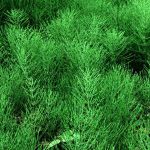| Common Name: |
Bottlebrush |
| Other Names: |
Field Horsetail, Horsetail, Horsetail Plant, Horse Willow, Pewterwort, Shave Grass |
| Botanical Name: |
Equisetum arvense |
| Genus: |
Equisetum |
| Family: |
Equisetaceae |
| Location: |
Europe to C China, N America, and Greenland |
| Cultivation: |
Moist soil in sun or partial shade. Horsetails are invasive and difficult to irradicate, Equisetum species are subject to statuatory control as a weed in parts of Australia. |
| Propagation: |
By seed sown when ripe; by division after flowering, or in autumn; by rhizome sections in warmth in winter. |
| Harvest: |
Stems are cut at any time during the growing season and dried for use in decoctions, infusions, liquid extracts, and powders. |
| Height: |
20-80cm (8-32in) |
| Width: |
Indefinite |
| Hardiness: |
Z6-10 |
| Parts Used: |
Above ground parts, Stems |
| Properties: |
An astringent, healing herb that acts mainly on the genito-urinary system and controls both internal and external bleeding. |
| Medicinal Uses: |
Internally for prostatitis, incontinence, cystitis, and urethritis. Often used with Hydrangea arborescens (See, Wild Hydrangea) for prostate problems. Internally and externally for hemorrhage. An irritant, best combined with demulcent herbs, and restricted to short term use.
To treat kidney stones, rheumatic disease, gout, brittle fingernails, loss of hair, frostbite, ulcers, and wounds. Germany's Commission E has approved the use of horsetail to treat urinary tract infections, kidney and bladder stones, wounds, and burns. |
| Typical Dose: |
A typical daily dose of horsetail is approximately 6 gm of the herb, taken with plenty of fluids. |
| Possible Side Effects: |
Horsetail's more common side effects when taken internally include thiamin deficiency. Used externally, it may cause seborrheic dermatitis. |
| Drug Interactions: |
| Taking horsetail with these drugs may increase the risk of hypokalemia (low levels of potassium in the blood): |
| Acetazolamide, (Apo-Acetazolamide, Diamox Sequels) |
Azosemide, (Diat) |
Bumetanide, (Bumex, Burinex) |
| Chlorothiazide, (Diuril) |
Chlorthalidone, (Apo-Chlorthalidone, Thalitone) |
Ethacrynic Acid, (Edecrin) |
| Etozolin, (Elkapin) |
Furosemide, (Apo-Furosemide, Lasix) |
Hydrochlorothiazide, (Apo-Hydro, Microzide) |
| Hydroflumethiazide, (Diucardin, Saluron) |
Indapamide, (Lozol, Nu-Indapamide) |
Mannitol, (Osmitrol, Resectisol) |
| Mefruside, (Baycaron) |
Methazolamide, (Apo-Methazolamide, Neptazane) |
Methyclothiazide, (Aquatensen, Enduron) |
| Metolazone, (Mykrox, Zaroxolyn) |
Olmesartan and Hydrochlorothiazide, (Benicar HCT) |
Polythiazide, (Renese) |
| Torsemide, (Demadex) |
Trichlormethiazide, (Metatensin, Naqua) |
Urea, (Amino-Cerv, UltraMide) |
| Xipamide, (Diurexan, Lumitens) |
| Taking horsetail with these drugs may increase the risk of drug toxicity: |
| Digitalis, (Digitek, Lanoxin) |
Lithium, (Carbolith, Eskalith) |
| Taking horsetail with these drugs may increase stimulation of the central nervous system: |
| Caffeine-Containing Drugs, (such as Alka-Seltzer Morning Relief Tablets, Cafergot, Excedrin Extra-Strength) |
Theophylline, (Elixophyllin, Uniphyl) |
|
| Disease Effects: |
May harm heart and kidney function by encouraging the secretion of too much potassium. |
| Food Interactions: |
- May cause increased central nervous system stimulation when used with caffeinated beverages such as coffee or tea.
- May break down thiamin (vitamin B1), increasing the risk of thiamin deficiency.
- Increased risk of chromium toxicity when taken with chromium supplements due to chromium content of horsetail.
- Increased central nervous system stimulation when used with tobacco or nicotine.
|
| Supplement Interactions: |
- Increased risk of cardiac glycoside toxicity when used with other herbs that contain cardiac glycosides, such as Black Hellebore, Calotropis, Motherwort, and others.
- Increased risk of cardiotoxicity due to potassium depletion when taken with cardioactive herbs, such as Adonis, Digitalis, Lily-Of-The-Valley, and Squill.
- Increased risk of potassium depletion when used in conjunction with Licorice.
- Increased risk of potassium depletion when used with stimulant laxative herbs, such as Black Root, Cascara Sagrada, Castor Oil, and Senna.
- Increased risk of chromium toxicity when taken with chromium supplements or herbs containing chromium, such as Brewer's Yeast, and Cascara Sagrada.
|
| Bibliography: |
Encyclopedia of Herbs by Deni BrownCopyright © 1995, 2001 Dorling Kindersley Limited. pp. 203
The Essential Herb-Drug-Vitamin Interaction Guide by Geo. T. Grossberg,MD and Barry Fox,PhD Copyright©2007 Barry Fox,PhD. Pp.277-279 |

